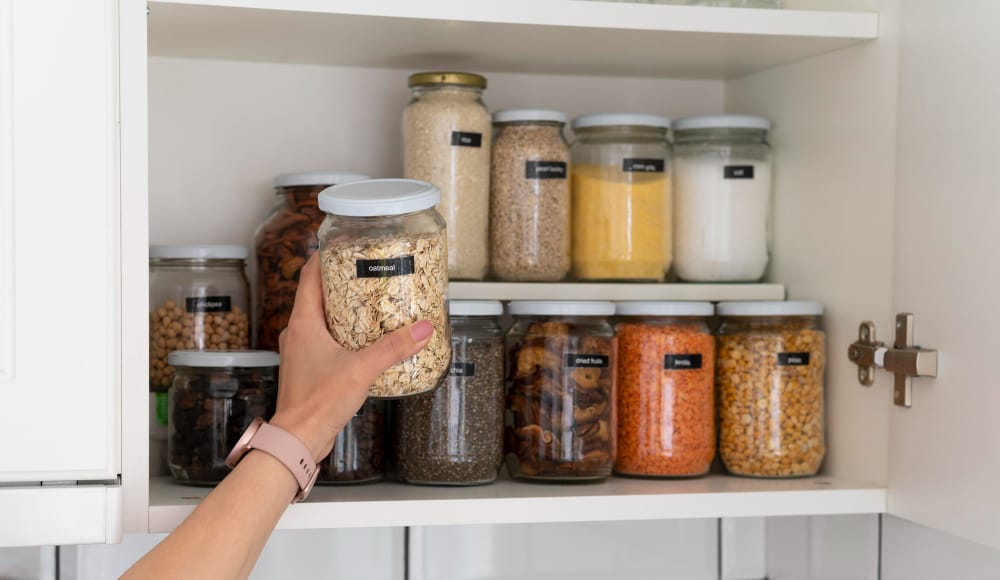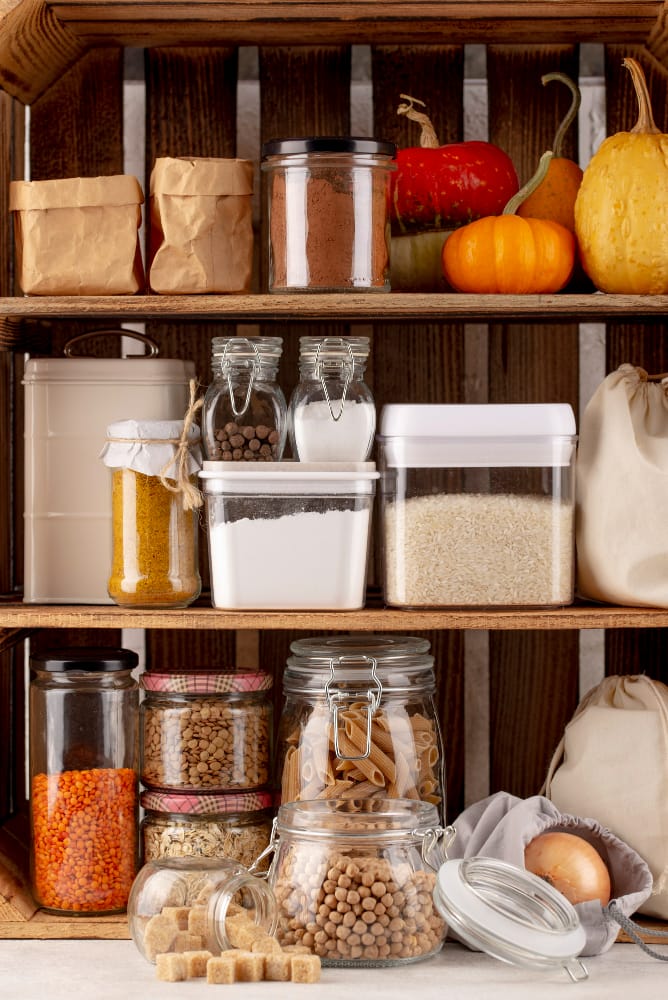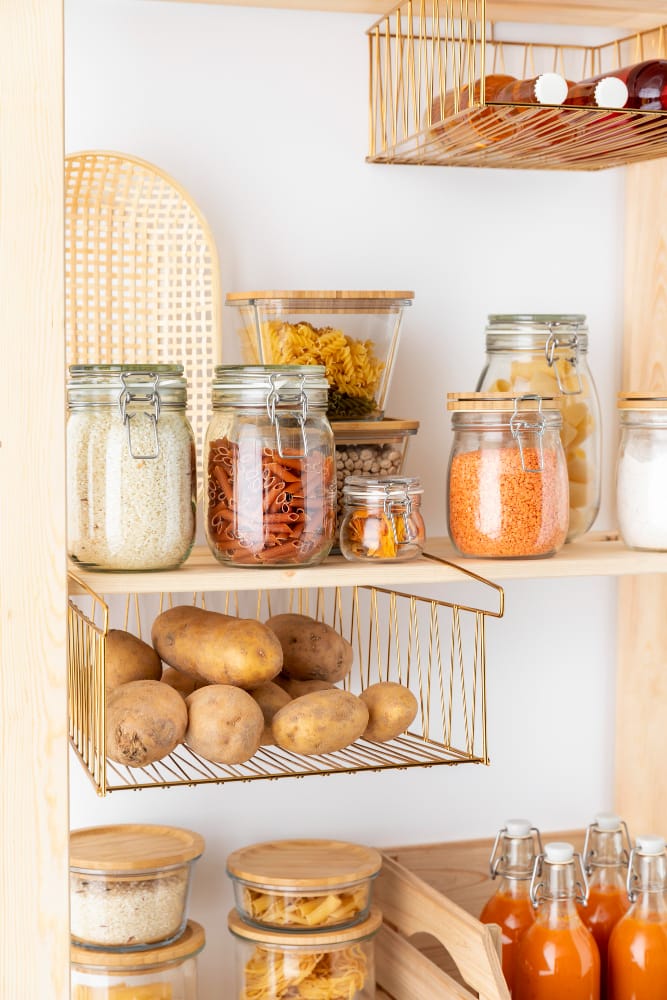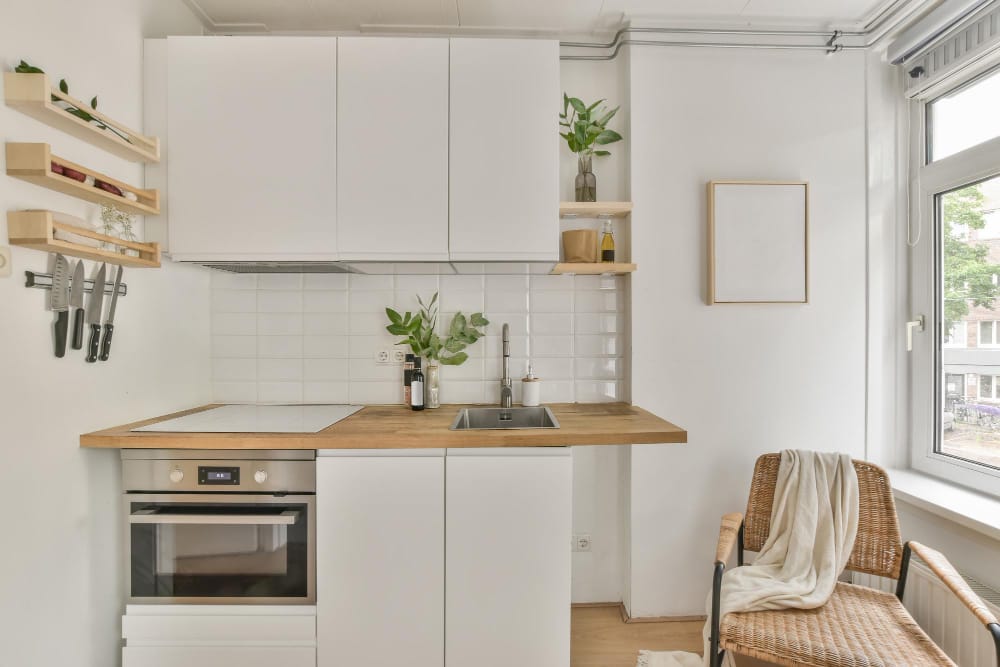
Table of Contents
Introduction About 7 steps for organizing kitchen cabinets
Here we are giviving you introduction about 7 steps for organizing kitchen cabinets.Imagine a kitchen where everything is neatly organized, and finding the ingredients or cookware you need is a breeze. An organized kitchen not only simplifies your daily cooking routine but also adds a sense of tranquility to your home. This comprehensive guide will take seven steps to help you conquer kitchen cabinet organization. These steps will lead you through decluttering, cleaning, categorizing, optimizing, arranging, labeling, and maintaining your cabinets, resulting in a beautifully efficient kitchen.

Step 1: Declutter Your Cabinets
To begin your journey toward a more organized kitchen, it’s essential to declutter your cabinets. Over time, kitchens accumulate items that may no longer serve a purpose. Here’s how to tackle this step:

1.1 Empty Everything: Start by emptying all your cabinets. This will provide a clean canvas and allow you to assess what indeed belongs in your kitchen.
1.2 Smart Sorting: Create three piles: items to keep, discard, and donate. Consider food items’ frequency of use, duplicates, and expiration dates when deciding what to keep.
1.3 Eliminate Expired Items: Be ruthless in discarding expired items, from spices to canned goods. This frees up space and ensures that your ingredients are fresh and safe to use.
Step 2: Clean Your Cabinets
Clean cabinets look better and provide a hygienic environment for your kitchen supplies. Here’s how to tackle this step:

2.1 Gather Supplies: You’ll need cleaning materials such as a gentle cleaner, warm water, microfiber cloths, and a vacuum or broom for removing crumbs and dust.
2.2 Thorough Cleaning: Use a mixture of warm water and a mild cleaner to clean all cabinet surfaces inside and out thoroughly. Pay special attention to any sticky or greasy spots.
2.3 Dust and Debris: Before returning items to your cabinets, vacuum or sweep the cabinet interiors to eliminate any remaining dust or debris.
Step 3: Categorize Your Items
Efficient categorization is the foundation of a well-organized kitchen. Grouping similar items makes it easier to find what you need. Here’s how to do it:

3.1 Create Categories: Consider the types of items in your kitchen and establish categories accordingly. Consider categories like cooking utensils, baking supplies, pots and pans, spices, and dinnerware. Tailor these categories to suit your specific needs.
3.2 Thoughtful Sorting: Place items into their respective categories. This visual organization will help you see the quantity of each item and ensure that similar items are stored together.
3.3 Space Assessment: As you categorize, take note of the space requirements for each category. This will assist you in planning your cabinet layout in the upcoming steps.
Step 4: Optimize Storage with Organizers
Now that your cabinets are streamlined and clean, optimizing your storage space using various organizers is time. Organizers help maximize space utilization and maintain neatness. Here are some organizer options:
4.1 Shelf Dividers: To create distinct sections within your cabinets, implement shelf dividers. These are ideal for stacking dishes or keeping baking sheets upright.
4.2 Bins and Baskets: Use bins and baskets to group similar items within your cabinets. They work wonderfully for snacks, condiments, or small kitchen gadgets.
4.3 Spice Racks: Invest in spice racks or pull-out spice organizers to keep your spices well-organized and within easy reach.

Step 5: Arrange Items by Frequency of Use
Strategically placing items in your cabinets based on their frequency of use ensures quick access to what you need. Consider these tips:
5.1 Upper Cabinets: Reserve upper cabinets for items you use less often, such as specialty cookware, serving dishes, or seasonal items.
5.2 Lower Cabinets: Keep frequently used items within easy reach in lower cabinets. This includes pots, pans, mixing bowls, and everyday dishes.
5.3 Kitchen Zones: Group related items together based on their function. For example, create a cabinet for baking supplies, another for cooking utensils, and a separate one for dinnerware. This makes it intuitive to find what you need while cooking.
5.4 Ergonomic Considerations: Store heavy items like pots and pans in lower cabinets to prevent straining your back when lifting them. Place lighter items, such as glassware, on higher shelves.

Step 6: Label Your Cabinets
Labeling your cabinets is a practical way to maintain order and ensure everyone in your household can quickly locate items. Get creative with your labeling ideas

6.1 Labeling Materials: Gather labeling materials like chalkboard labels, adhesive labels, a label maker, or decorative stickers.
6.2 Cabinet Categories: Create labels for each cabinet or category, indicating where items belong. Choose between straightforward labels or infuse your style with fonts and designs.
6.3 Chalkboard Labels: Chalkboard labels offer versatility as you can change labels when needed. Use chalk or chalk markers for writing.
6.4 Adhesive Labels: Adhesive labels provide a clean and modern look, perfect for a minimalist or contemporary kitchen.
Step 7: Maintain Your Organization
Maintaining an organized kitchen is an ongoing effort. To ensure that your kitchen remains efficient and visually pleasing, follow these strategies:

7.1 Regular Inspections: Schedule regular cabinet inspections to promptly identify and address any clutter or disorganization.
7.2 Seasonal Overhauls: Conduct more thorough reviews of your cabinets seasonally. Declutter and rotate items as necessary.
7.3 Engage Everyone: Encourage all family members to follow the organization system and familiarize them with where items belong.
7.4 Teach Young Ones: If you have children, involve them in maintaining the kitchen’s organization. Teach them the importance of putting items back in their designated places.
7.5 Be Flexible: Be open to adjusting your organization system if it’s not working optimally. The goal is to create an efficient kitchen that suits your needs.
7.6 Celebrate Success: Recognize and celebrate your efforts in maintaining an organized kitchen. A well-organized kitchen contributes to a harmonious home environment. So these were the 7 steps for organizing kitchen cabinets.

Conclusion
In conclusion, by following 7 steps for organizing kitchen cabinets, you’ll master the art of kitchen cabinet organization and transform your cooking space into a functional and inviting haven. Decluttering, cleaning, categorizing, optimizing, arranging, labeling, and maintaining your cabinets will make cooking more efficient and bring a sense of order to your home.
Investing time and effort into organizing your kitchen cabinets will yield countless benefits. You’ll quickly locate ingredients and cookware, allowing you to focus on creating delicious meals for yourself and your loved ones. It’s a journey worth embarking on. Here we arequesting you to visit over more informative blogs likehttps://lifestyleelevate.com/developing-healthy-eating-habits/
FAQs about 7 steps for organizing kitchen cabinets
1. Why should I bother organizing my kitchen cabinets?
- Organizing your kitchen cabinets makes it easier to find items, saves you time during meal preparation, reduces clutter, and creates a more functional and visually pleasing kitchen.
2. How often should I organize my kitchen cabinets?
- Organizing your kitchen cabinets at least once a year is a good practice. However, you should do it more frequently if you notice clutter accumulating.
3. What’s the first step in organizing kitchen cabinets?
- The first step is to declutter your cabinets by removing everything and sorting items into keep, discard, and donate categories.
4. What’s the best way to clean kitchen cabinets?
- Use warm, soapy water and a microfiber cloth for general cleaning. A mixture of water and vinegar can be effective for stubborn stains or grease. Avoid abrasive cleaners that may damage the finish.
5. How can I keep my cabinets smelling fresh?
- Place open containers of baking soda or activated charcoal inside your cabinets to absorb odors. You can also use scented drawer liners or sachets.
6. Should I use clear containers for pantry items?
- Clear, airtight containers are ideal for pantry items like flour, rice, and pasta. They keep ingredients fresh and make it easy to see when supplies run low.
7. What’s the best way to arrange pots and pans in cabinets?
- Store pots and pans with their lids, using dividers or racks to keep them organized. Place heavier items in lower cabinets to avoid strain when lifting.
8. How do I prevent cabinet shelves from sagging under the weight of dishes?
- Consider using shelf liners or investing in sturdier shelves. Distribute weight evenly and avoid overloading shelves.
9. What’s the benefit of labeling kitchen cabinets?
- Labeling cabinets help maintain order, ensures everyone in the household can find items, and adds a personalized touch to your organization system.
10. How can I involve my kids in kitchen cabinet organization?
– Assign a low cabinet or drawer for children’s dishes, cups, and snacks. Teach them where their items belong and encourage them to put things away.
11. What’s the best way to organize spices in a cabinet?
– Use a spice rack, pull-out organizer, or tiered shelf to arrange spices alphabetically or by type. Label the spice lids for quick identification.
12. Can I use over-the-door storage for cleaning supplies?
– Over-the-door solutions are great for storing cleaning supplies, pot lids, cutting boards, or kitchen towels.
13. How can I maintain the organization of my kitchen cabinets long-term?
– Regularly check your cabinets for clutter, involve family members in maintaining the system, and conduct seasonal reviews to declutter and reorganize as needed.
14. Are there eco-friendly options for kitchen cabinet organization?
– You can find eco-friendly organizers made from materials like bamboo, recycled plastic, or metal. Consider repurposing or upcycling items as well.
15. Can I mix and match different organizer types in my cabinets?
– Absolutely! Mixing and matching organizers can help you maximize space and customize your organization to suit your needs and cabinet sizes.
If you want to read more about 7 steps for organizing kitchen cabinets you should visit https://www.lilyanncabinets.com/cabinet-articles/how-to-organize-kitchen-cabinets/


